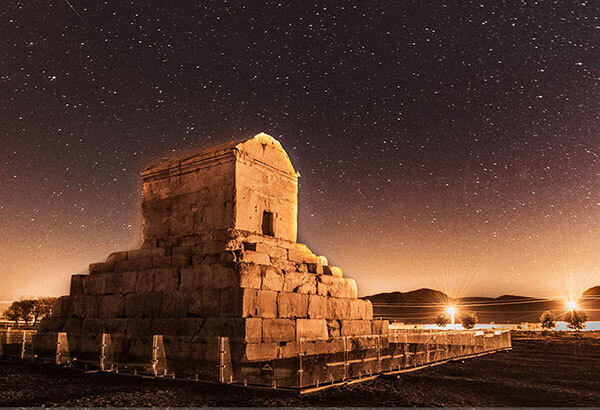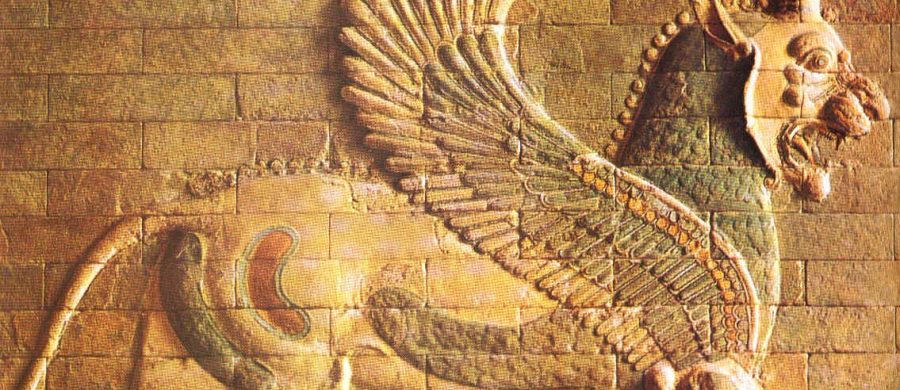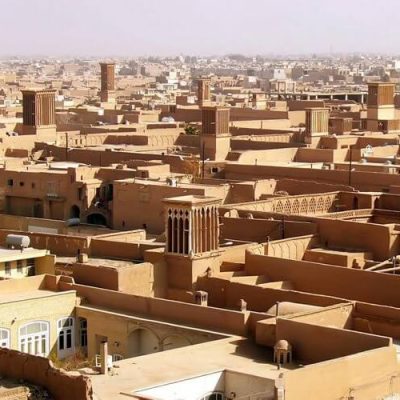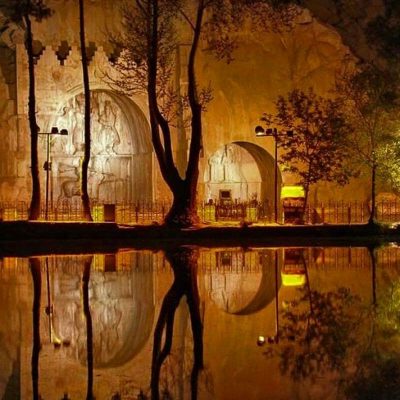Most of the Achaemenid artworks are manifestation of desires and mundane operations and represent the philosophical, mythological, and ritual prospective. Some examples of those abundant artworks are listed below:
Pasargadae:
It is the remains of one of the most important city of the Achaemenid Empire, founded by Cyrus the Great, in about 547 AD. The city is located in northeastern part of Shiraz. In Pasargadae, there was a fortress on which, after being conquered, Cyrus laid the cornerstone of his kingdom. Many believe the city was a garden city and the remains of three Grand Palaces obtained from the heart of the garden. These gardens with central palaces are often called Paradise. They are also referred to by the same name in Europe and other cultures.
Unfortunately, there is nothing left from that city garden but huge colonnaded palaces. Cyrus’s private palace was consisted of a hall with 30 colonnades as well as 4 side colonnaded porches. But the central hall of the palace is formed on 8 columns in two rows and only a single colonnade has remained.
On the left side of the campus, there is a gate with a winged man carved on its northern side. This figure shows a man standing with four wings, and wearing Elamite dress and a crown of Egyptian Gods.
Some attribute this figure to Cyrus or Dhul-Qarnayn referred to in the Holy Quran. Some others recognize it as a fantastic creature guarding the gates.
Another majestic monument in these series is the Cyrus’ tomb. The stony tomb is composed of carved and luxury stones for both the upper chamber and the platform. Its length and terraced formation envisage ziggurats.
After centuries, Cyrus’ glory and honor has not lowered and multiple caravan-serais around his tomb are indicating the tourists who come to visit his tomb.

Shush:
Shush is now located on the way from Andimeshk to Ahvaz in Khuzestan. This campus contains the Acropolis, Kingdom City, artisan town, and Apadana. But the most important monument is Apadana palace. This palace that was for the king’s winter stay is composed of two parts: colonnaded halls and residential campus. The Hall is very similar to what we see in Persepolis. Decorative components of the building are bricks glazed with topics such as hunting.
Dahaneh- Qolaman:
The remains of this city are located in the village of Qale-Now, near Zabol, Sistan and Baluchestan. It is almost the only ordinary residential city remained from that era. The buildings in this ancient city are government building, religious building for group worshiping, and residential buildings with a central courtyard which is a distinct feature of Iranian architecture.
This city is probably the Zarankay city referred to by historians such as Ctesian and Ezodor Charax.
Persepolis:
This historical city is located in the northeast of Shiraz. After translating the Persian obituary, it was named “Persp Thewlis”, that is city devastator. Later, the name was renamed by the Greeks as “Persepolis” meaning Persian city. The historical documents prove that Achaemenids themselves called it Parseh.
This archaeological campus contains the ruins of the palaces, royal castle, and Parseh city which was founded by Darius I and was completed by his successors over time. Of course, at the time of its destruction by Alexander, some parts were not still completed.
The most intact part of this historical campus is royal castle which is located on a platform overlooking the Mount of Mercy. Using high platforms to build palaces was Assyrian’s innovation. The platform is a combination of nature and hand-made art.
The most prominent part of the royal castle is called Apadana Hall. This squared hall has sides with lengths of 60 meters and its distance from the floor is made by stairs in the northern and eastern fronts. Each of these stairs is of low height, which makes it easier for guests and the royal family to move. On the walls of this palace, there are outstanding beautiful images of different countries’ guests with gifts in their hands. These images are considered as a good source for identifying different tribes’ clothing and local gifts. They attract the attention of an audience toward their beauty and elegance.
Other important buildings of the Persepolis royal castle include the Hall of 100 columns, Central palace, Hadish Palace, and Techra Palace, each one having its unique stunning beauty.
The tomb of the Achaemenid:
Achaemenids believed that polluting soil by dirty body is an unforgivable sin. That’s why they left the dead in the mountains or dug holes as graves to put the dead bodies. Samples of such graves have been observed abundantly among the Persians and Medes tribes.
Unlike Mud’s catacombs, Achaemenid tombs have equal shapes and appearances. The catacombs show a Cross image from the distance. Above the Cross, representatives of the United Nations along with the king are carrying his throne and a big Forouhar, i.e. angel, above them attracts the viewer’s attention. The tombs had sliding stony doors and they were never opened after being closed. But it seems that they have broken down and torn apart over time.
Mount Behistun:
After the victory over the internal enemy, Darius commanded sculpting this work at a place called Bagistana or Baghestan. Bagh means the place of God. Due to being close to Khorasan main way, this place has been a good place for government propaganda. In its image, we see Darius the Great who has laid Guillaume or false king back on the ground and captured him.
In another part of this inscription, a text is written in Persian cuneiform: I am Darius. King of Kings, Great King, King of Persia and lands, Son of Achaemenid Vishtasb.
At the top of Mazda symbol, there is a ring stretched out toward Darius. This symbol is repeated many times in the past Iranian culture and it is now continuing. Delegation of the Kingdom from God and the relationship of kingdom with the divine state has been archetypal in this ancient land.
Read about Iran visa application in this link : https://iranatour.com/iran-visa/









Post Discussion